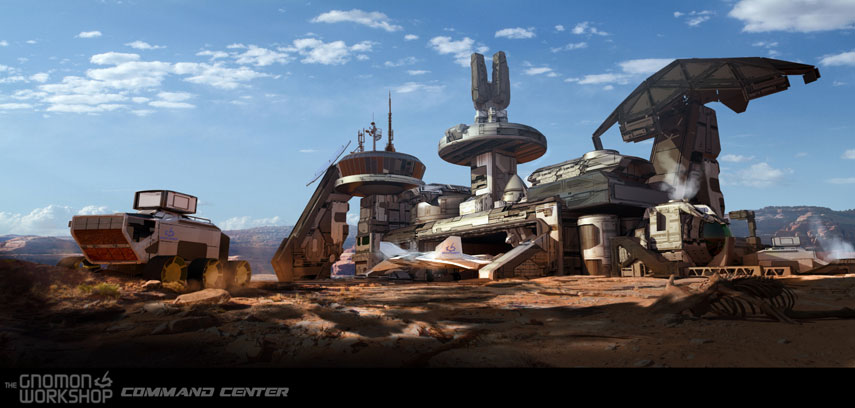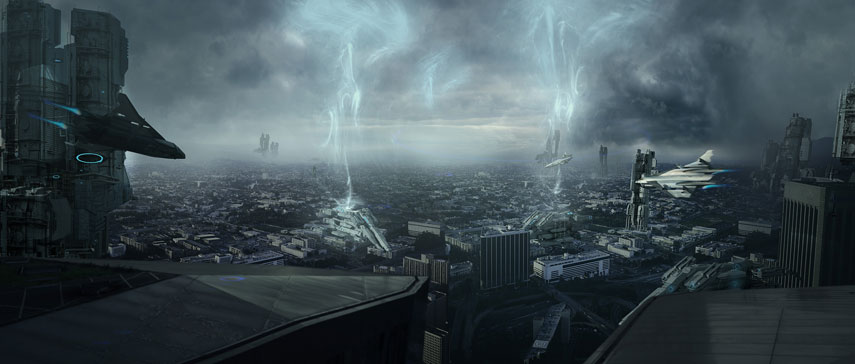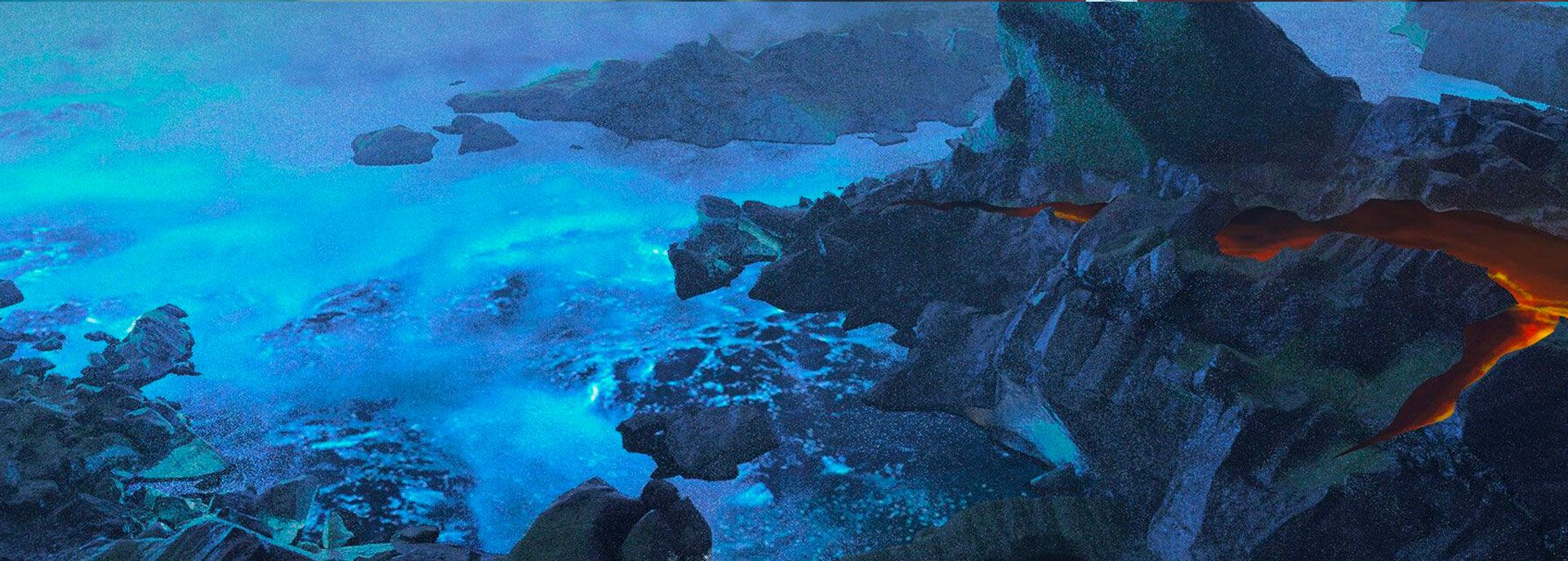Olivier Dubard is a the definition of well-rounded when it comes to designing and creating production-ready environments and concepts for film and cinematics. With a background studying comics and illustration and a certificate from the Gnomon School of Visual Effects, Games + Animation in Hollywood as a 3D generalist, Olivier has a command of skills that have landed him jobs working on such films as Marvel’s Black Panther, The Huntsman, Star Trek Beyond and Terminator Genisys, among others, creating digital environments and concepts for studios like Digital Domain, Double Negative, The Mill LA and Sony Pictures Imageworks. Passionate about his craft, we’re grateful to have him here to talk a bit about his experiences and background, his two titles for The Gnomon Workshop, and some things you should consider if you’re interested in working on CG environments or want to amp up your range of skills.
GW: Can you tell us about the moment you knew you wanted to create art for films? Were you always into art as a kid?
OD: I remember watching the making of the first Jurassic Park, and by the end of the documentary, I realized that you can have a career making visual effects for movies. That moment, at the age of 11, I told myself that I would be working on Hollywood blockbuster movies one day. When I was a kid, I was drawing all the time, and I remember filling out pages of my favorite characters.
GW: You now have two titles for The Gnomon Workshop under your belt, Visual Development for Environments and Environment Creation for Film and Cinematics, which really display your wide range of skills, from drawing and design ideation, to modeling, texturing, lighting and lookdev, to a final render of a gorgeous matte painting. Do you think it’s important for artists looking to work in production to take a generalist track in their studies?
OD: I would recommend that they have curiosity. It is important to be a generalist for environment artists. Taking the generalist track teaches you how to be open about solving problems. Artists who want to specialise don’t have to take the generalist track, but I would recommend to have an open mindset, as well. In production, each department works hand in hand together. It is crucial to understand other departments’ work processes and requirements to collaborate efficiently. In my case, when it comes to making an environment, taking ownership of your shots is what it boils down to. Being able to model, texture, shade, and light are usually the main skills the environment artist needs to possess. In addition, matte painting and projections would not be necessarily a requirement, but having that extra skill will set you on a successful path to being a well-rounded environment artist. You will also understand better how the pipeline is tied together, and make better decisions because of the complex nature of making full environments.

GW: If you had to specialize in one thing only, what would it be?
OD: If I had to specialize in one area, this would be concept art. Concept design is very fulfilling and challenging. Creating a new design that corresponds to the director’s vision is what makes it challenging. But making sure that the design will work on the screen adds another level of difficulty. If these two criteria are met, concept art can be very satisfying.
GW: You use an impressive array of software in your tutorials! Can you share a little insight into what you use Maya for vs. MOI 3D and ZBrush when building out models? And then on the 2D and compositing side, what’s your basic pipeline through Nuke, Sketchbook Pro and Photoshop?
OD: For everything related to layout, camera lenses, modeling, UVing, look development and lighting, I use Maya and V-Ray to render. I also utilize Maya to make my assets ready for production. When I concept hard surface objects, I use MOI 3D from time to time, depending on what is faster. ZBrush is only used when I need to sculpt organic objects, add scratches on a hard surface object, or sculpt destruction assets. Once I have all my passes rendered, I am pre-compositing them to match my concept from 80 to 90 percent. This prepares the plate I will be painting on for the matte painting. Once the matte painting plate is exported, I paint the sky and paint over CG when needed in photoshop. Sketchbook Pro is used only for line drawing at the very early stage, and only when I am scribbling ideas.
GW: How did coming to Los Angeles and studying at Gnomon prepare you for working in production?
OD: I learned two of the most important lessons from Gnomon - first, making friends. Spending a lot of time in the labs working hard creates strong bonds. And secondly, being a professional at how to present your work. Gnomon’s program is designed to teach all the essential components you need to become a great generalist. The analogue classes are very helpful to keep the traditional crafting essence. The digital classes really taught me how to stay open, and develop a problem-solving mindset. At the end of the two years for the certificate program, I had the chance to be with Alex Alvarez for the demo reel classes. This is where we all push our work in order to apply for work. In Alex’s class, we had two weeks to produce a demo reel, with a professional quality, and it really taught me how to plan accordingly and efficiently.
GW: Do you have any other advice or tips from your experiences for students or artists trying to up their game and expand their skills?
OD: Always be a student. Learn as much as you can, be hungry for knowledge, and remember the path of an artist is a long one. Don’t be afraid to ask for help or take a class to fill up the gaps in your skillset. Never settle for what you have, and always push the quality of your work until you feel you can’t anymore. Staying passionate about what you do, and what you wish to accomplish is essential. Try to get as much momentum as possible, because this is what you love doing the most and there are no other options. As a personal example, I never saw any other career path for myself, and even when the times got rough, I knew that being part of the industry is what I was striving for.

GW: Some upcoming 2018 films you’ve worked on include Hotel Transylvania 3: Summer Vacation, and Sony Pictures’ animated Spider-Man: Into the Spider-Verse. What made you want to try your hand at working on CG-animated films and what have you taken away from the experience, so far?
OD: This is my first animated feature film experience. I was hoping for the opportunity to come and I am glad it happened with Sony Pictures. It has been a great learning experience for me. Animated films are different from VFX shows. In animation, we are following a style guide and push the contrast and colors in order to make it appear more cartoony. It is also more painterly; we hand paint almost everything. We rely less on photo references but more on painting our elements from scratch. The pace is a lot slower, and we have more time to work on shots. In film, we follow the plate, this is what dictates the final outcome most of the time, although we have more freedom especially when it comes to environments. The environment department is composed of people with a wide range of skills, such as matte painters, generalists, modelers, texture artists and lighters. We also have people like me that are generalists, being able to do 3D and matte painting. If you have both skills you can rotate a lot in the department, and this can also mean being assigned a whole shot, where you can build and finish it by yourself. It also helps to have concept skills, as we don’t always have concept art. The film pace is faster than animation. It requires to work more efficiently and be ready for sudden changes.
GW: Black Panther is the newest addition to the MCU and in theaters, and you got to work on costume and environment design for the film while at Method Studios. What can you tell us about what it was like working on a Marvel film?
OD: Working on a Marvel film is always very exciting, but it is even more so when you get to design and create the look of it. I studied comic books because I was a long-time fan of Marvel comics. The influence of their comics on my student work during my comic book years at school has been significant. Marvel possess such a vast universe, which is amazing to be part of and to bring to the screen.
GW: You also worked on the Call of Duty: Black Ops 2 trailer and the cinematic for the game, World of Tanks: War Stories. How is working on a game a different experience from film?
OD: Game cinematics and film are a combination of both animation and live-action. To be more precise, I worked on a pre-rendered cinematic, and not real-time. The pipeline is fairly the same as film, instead of having a live-action plate, everything is rendered. There is a style guide just like animation, but it’s less restraining. Similarly to live-action, we have more freedom to play with the environment than being too restrained by it.

GW: So, what’s next? You’ve worked on both the pre-production and production sides of film and cinematics. Do you see yourself using your arsenal of skills more toward concept design and further into art direction in the future, perhaps creating more unforgettable environments for films like Disney’s Beauty and the Beast, or do you plan on blazing down any new, unexplored trails?
OD: I like making the overall look of the shots, which is what naturally got me interested in concept art and art direction. That is also why I am seeking to develop my career towards that direction in the future. Using production tools to create concepts is very powerful, and gives me tremendous freedom. I can approach ideas with the same tools from a production standpoint, and design the blueprints for the rest of the filmmaking process. Using CG speeds up some of the tasks, for example, rendering a concept shot with different lighting scenarios can be done fairly quickly. The explorations and ideations can be done in a pretty flexible way. Techniques like this give a quick and wide range of designs with the final look already predetermined.
GW: You’ve studied illustration and comics in the past. Do you have any stories you might someday tell in that medium?
OD: The idea of making a CG comic book has crossed my mind many times. It is in my projects “to-do list” for the future, as I would like to mix the two mediums together. My wife and I love making stories, and we have a bunch of stories we’d like to develop. We’ll keep working on it until we are ready to produce a comic book or a short film.
GW: Are you working on any other personal projects you can tell us about?
OD: I am preparing a new personal project from concept to final shot. It will be a bigger and longer project that I am planning on making fully CG. It will be a production piece with art direction. For each new piece, I like to challenge myself with new software and subjects. I am learning Substance Painter at the moment, and will use that for my next projects.

GW: Your recent portfolio includes environments and architecture, of course, but also vehicles, Gundam mechs, and even occasionally, costume design. What’s your favorite kind of stuff to work on and why?
OD: My favorite subjects are environments and props, but I am also interested in broader subjects and always exploring new territories. There are many architectural styles I wish to cover. Asian architecture is what I would like to tackle more. I am very fond of the way Chinese and Korean cultures built their temples and castles. I would say that modern and medieval Asian architecture really inspires me. The colors and patterns really push me to get to know why it was built that way, and for what purpose.
GW: Thank you so much for your time, Olivier! Any parting words?
OD: Stay passionate and positive about making your art. Share your knowledge and more will come back at you for doing so. Thank you for interviewing me, and giving the opportunity for people to learn from industry experts.




Related News
Beauty in the Beast: Neville Page on Burnout, Mindset & Creative Survival
May 07, 2025
Beauty, Beasts & Better Pipelines: Neville Page on Digital Design & Practical Makeup
May 07, 2025
Capturing Assets & Environments for Call of Duty: An Interview with Gui Rambelli
Feb 10, 2025